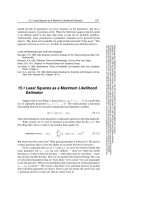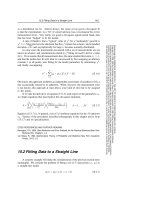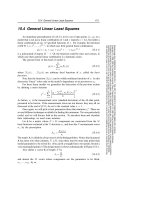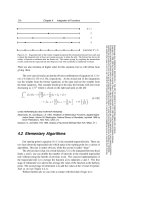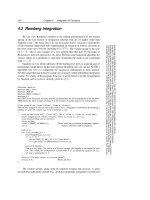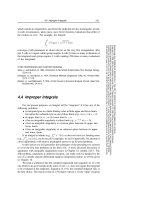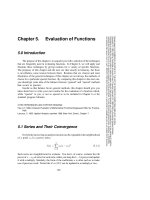Tài liệu Impact of Culture on Depressive Symptoms of Elderly Chinese Immigrants doc
Bạn đang xem bản rút gọn của tài liệu. Xem và tải ngay bản đầy đủ của tài liệu tại đây (98.99 KB, 8 trang )
Original Research
Impact of Culture on Depressive Symptoms of Elderly
Chinese Immigrants
Daniel WL Lai, PhD
1
Key Words: depression, elderly Chinese immigrants, prevalence of depressive symptoms,
Chinese-Canadians
D
epression is a common mental health problem affecting
10% to 15% of the elderly population in North America
(1–4). The growth of cultural diversity in the North American
population has resulted in research studies examining depres
-
sion among elderly persons of ethnic minority backgrounds,
including those of Japanese (5), Korean (6), Mexican (7),
Native American (8), and Chinese (9) background. In general,
prevalence of depressive symptoms among the ethnic minor
-
ity elderly was higher than that among the general elderly.
While some may attribute the variation to cultural differences,
820
W Can J Psychiatry, Vol 49, No 12, December 2004
Objectives: The impact of culture on mental health has been inadequately researched. This
study examines the effect of cultural factors on the depressive symptoms reported by
elderly Chinese immigrants in Canada.
Method: Data from 1537 elderly Chinese immigrants who took part in a cross-sectional
multisite survey on the health and well-being of older Chinese-Canadians were used.
Participants were identified through telephone screening of randomly selected telephone
numbers listed with Chinese surnames. A structured questionnaire was used to conduct
face-to-face interviews. A Chinese version of the 15-item Geriatric Depression Scale was
used to assess depressive symptoms.
Results: Close to one-quarter of the elderly Chinese immigrants reported having at least a
mild level of depressive symptoms. Having more cultural barriers and a higher level of
identification with Chinese cultural values resulted in a higher probability of being
depressive.
Conclusions: The importance of the sociocultural determinants of mental health is
demonstrated. The health delivery system should be more sensitive to the unique ethnic
and cultural differences of older immigrants.
(Can J Psychiatry 2004;49:820–827)
Information on funding and support and author affiliations appears at the end of the article.
Clinical Implications
·
The health system should pay additional attention to the cultural uniqueness of service users
and should enhance cultural appropriateness in service provision.
·
Medical professionals should extend their clinical attention beyond symptoms and attend to
the cultural values and barriers in health assessment.
·
Baseline studies on depressive symptoms should be conducted and used as indicators for
assessing the effectiveness of intervention strategies at policy and patient levels.
Limitations
·
This study only included participants in community dwellings and could not be generalized to
other subgroups, such as those who were institutionalized.
·
This study was done in a community setting and is not able to establish clinically significant
cases in this population.
·
Without using a longitudinal design, the cross-sectional survey was unable to establish the
causal impact of the predictors.
it is unclear how the culture of the ethnic minority elderly
affects depressive symptoms.
Culture is an important social determinant of health (10).
However, efforts to examine culture have often focused on the
differences between various ethnic groups (11–13), leading to
the perpetuation of a cultural homogeneity assumption. This
study examined the impact of intragroup cultural variations
on depressive symptoms of elderly Chinese in Canada.
While depression is a major mental health threat to many
Canadians (14), it is important to study the elderly Chinese for
3 reasons. First, Chinese Canadians have a lengthy settlement
history in Canada and belong to the largest visible minority
group; second, population aging in this group is the fastest
among all visible minority groups. Among Chinese, the
elderly population accounts for about 10% of its population,
representing a 50% increase from 1996 (15). Third, cultural
uniqueness shared by many Chinese Canadians, particularly
the elderly, provides a good example of how variations in tra
-
ditional culture and other cultural factors impact mental health
in Western society.
A search of Medline, Psycinfo, Cinahl, and AARP Ageline
resulted in over 150 research publications on depression
among elderly Chinese as of January 1, 2003. Among them,
only 7 studies examined depression of the elderly Chinese in
North America (9,16–21), and all reported a similarly high
prevalence of depression, ranging from 18% to 29.4%.
Self-rated health, living alone, perceived satisfaction with
family care, life satisfaction, social support, health status,
functional status, education, level of acculturation, and com-
mand of the English language were identified predictors
(9,16,17,20). Nevertheless, the concept of culture was not
addressed in these studies. The research question of this study
was as follows: How does the culture of older Chinese Cana
-
dians affect prevalence of depressive symptoms?
Method
Data were collected between June 2001 and March 2002 as
part of a larger research project entitled “Health and Well
Being of Older Chinese in Canada,” which examined the
health and culture of Chinese aged 55 years and over in 7
major Canadian cities, including Victoria, Greater Vancou
-
ver, Calgary, Edmonton, Winnipeg, Greater Toronto, and
Greater Montreal. The sample was obtained by calling ran
-
domly selected telephone numbers listed under Chinese sur
-
names in each city. Eligible participants were ethnic Chinese
aged 55 years and over. Those selected were invited to take
part in a face-to-face interview, using a structured question
-
naire covering a wide range of topics including socio-
demographic information, health status, service use, and
cultural values and beliefs. The interviews were conducted in
either English or a Chinese dialect spoken by the participants.
Written or verbal informed consent was obtained before the
interview. Finally, 2272 participants completed the research,
representing a response rate of 77%. In this study, 1537
elderly immigrants aged 65 years and over were included in
the analysis.
Measures
Depressive symptoms were measured by a revised Chinese
version of the 15-item Geriatric Depression Scale (GDS),
which was translated and adapted to better fit the cultural con
-
text of elderly Chinese in North America (22). Scores were
assigned to participants who indicated positive answers to
items that represent depressive symptoms. Participants with a
total score of 4 or under were considered “normal.” Those
who scored between 5 and 9 on the scale were considered
“mildly depressed,” and those who scored 10 or over were
considered “moderately-to-severely depressed.”
Three types of predictors, that is, sociodemographic vari
-
ables, physical health variables, and cultural variables, were
assessed. Previous research indicated an association between
depression and various sociodemographic factors such as age
(19), sex (23,24), marital status (25), income (26), self-rated
financial adequacy (27), living arrangement (19,28), religious
commitment (29), and education level (26). For elderly immi-
grants, English competency, country of origin, and length of
residency in Canada were variables relevant to immigrant sta-
tus and adjustment and were included in this study.
To measure self-rated financial adequacy, participants were
asked to indicate how well their income and investments satis
-
fied financial needs along a 4-point scale, ranging from “very
inadequate” to “very well.” English competency was assessed
with 2 questions that asked participants whether they were
able to comprehend English and whether they were able to
speak English; choices ranged from “very well” to “not at all.”
A score was assigned from the 2 questions to form a self-rated
English proficiency score ranging from 2 to 6. A higher sum
represented a higher level of English competency.
Research findings have consistently shown the positive
impact of social support on reducing the risk of depression
(30–33). In this study, social support was measured by 5 ques
-
tions adapted from the Older Americans Resources and Ser
-
vices (OARS) Social Resource Scale (34). These questions
assessed family structure, patterns of friendship and visiting,
availability of a confidant, and availability of a helper, should
the need arise. A score between 1 and 3 was assigned to each
response. Scores for all questions were summed to form the
social support index, ranged between 5 and 15, with higher
scores representing a higher level of social support.
Impact of Culture on Depressive Symptoms of Elderly Chinese Immigrants
Can J Psychiatry, Vol 49, No 12, December 2004 W 821
Physical Health Variables
Studies show that poorer health is a predictor of higher levels
of depression (28,35–37). The following 4 health measures
were used in this study:
1. Number of chronic illnesses. This was measured by asking
participants to indicate either yes (represented by 1) or no
(represented by 0) on a list of 24 common illnesses. A higher
score represented more illnesses.
2. Functioning capacity in activities of daily living (ADL) and
instrumental activities of daily living (IADL). ADL was mea
-
sured by asking participants whether they would need help in
self-care activities such as bathing and (or) showering or
dressing. IADL was measured by asking participants whether
they would need help in performing activities such as light
household chores. Participants were asked to indicate their
ability to perform each of the ADL and IADL, from no help
needed (a score of 0), to completely dependent on others (a
score of 3). All responses were summed to produce an ADL
index with a score ranging from 0 to 12 and an IADL index
with a score ranging from 0 to 24. Higher scores represented a
higher level of dependency.
3. The Physical Component Summary (PCS) of a Chinese ver-
sion of the Medical Outcomes Study 36-item Short Form
(SF-36) (38) is a standardized health assessment tool used
with people from various cultural backgrounds (39–42). The
PCS was used to measure the general physical health of partic-
ipants. It has a score range between 0 and 100, with higher
scores indicating better physical health.
4. Self-perceived health was measured by a question from the
SF-36, which asked participants to rate their own health status
from “poor” to “excellent,” represented by scores ranging
from 1 to 5, with higher scores indicating better health.
Four cultural variables were included in this study: Chinese
cultural values, Chinese health beliefs, ethnic identity, and
cultural barriers in accessing health services. Research has
shown that most acculturated or bicultural immigrants have
the lowest prevalence rates of depression and report them
-
selves as being healthy (43). This study assessed participants’
Chinese cultural values, using a list of 11 statements con
-
structed by the research team of the Health and Well-Being
Study. These statements reflect beliefs and values with
respect to such aspects of Chinese culture as language use, sex
roles, interracial marriage, food and diet, and parent–child
relationships. For each statement, participants were asked to
indicate their level of agreement along a 5-point scale ranging
from “strongly disagree” to “strongly agree.” The answers
were coded to form a sum ranging from 1 to 5, with higher
scores indicating a higher level of identification with Chinese
cultural values.
Chinese health beliefs refer to common concepts including
norms and health practices.
These were measured by a constructed list of 12 statements
related to areas such as eating, health maintenance, and use of
traditional Chinese medicine. Participants were asked to indi
-
cate their levels of agreement with each statement from “dis
-
agree” to “neither agree nor disagree” or “agree.” Responses
from 12 statements formed a combined score ranging from 1
to 3. A higher score represented a higher level of Chinese
health beliefs.
Ethnic identity is also an indicator determining the accultura
-
tion level of immigrants (44,45). Ten questions focusing on
the participants’ involvement in cultural activities and associ
-
ation with the Chinese community were constructed to mea
-
sure ethnic identity. The answers were coded and summed to
form an ethnic identity index ranging from 10 to 30, with
higher scores representing a higher level of Chinese ethnic
identity.
Service barriers affect access by those in need, which affects
the well-being of individuals (46,47). For older immigrants,
service barriers create inconveniences and could negatively
affect health. This study measured the following 5 culture-
related barriers identified in previous research (48): 1) “there
are no other Chinese clients/users,” 2) “the professionals there
are not Chinese,” 3) “the professionals do not understand your
culture,” 4) “the professionals there do not speak your lan-
guage,” and 5) “the programs are not specialized for Chi-
nese.” A score of 1 was assigned to each of the barriers
reported. Total scores ranged from 0 to 5, with higher scores
representing more cultural barriers.
Results
Table 1 presents the demographic information of the elderly
Chinese immigrants, indicating the diversity within this eth
-
nic group.
On average, participants were reported to have 3.1 depressive
symptoms, SD 3.2. According to the Geriatric Depression
Scale-Short Form (GDS-SF) cut-off point, participants were
placed into either a normal group or a group reporting at least a
mild level of depressive symptoms. The results indicate that
close to one-quarter (24.2%) of participants reported having a
mild level of depressive symptoms (that is, GDS-SF scores ³ 5).
An independent sample t test and chi-square test were used to
analyze the bivariate associations between depressive symp
-
toms and the predictors (Table 2). The following were all
associated with having depression: living alone, older age,
single status, female sex, less financial adequacy, religious
belief, lower levels of education, lower levels of social sup
-
port, and less monthly income. Participants who reported hav
-
ing depressive symptoms also reported having more chronic
822
W Can J Psychiatry, Vol 49, No 12, December 2004
The Canadian Journal of Psychiatry—Original Research
illnesses, a higher level of dependence in basic ADL, a higher
level of dependence in IADL, poorer physical health, and
poorer self-perceived health. Those who reported having
depressive symptoms reported a lower level of identification
with Chinese ethnic identity, a higher level of identification
with Chinese cultural values, a higher level of identification
with Chinese health beliefs, and more cultural barriers than
did those without depressive symptoms.
Hierarchical logistic regression was used to identify predic
-
tors of depressive symptoms, and the dependent variable,
depression, represented the proportion of participants consid
-
ered to suffer at least mild depression (that is, scoring 5 or
more depressive symptoms along the GDS). The predicting
factors were entered in blocks, beginning with the
sociodemographic variables (that is, sex, age, religion, marital
status, living arrangement, education, English competency,
country of origin, length of residency, financial adequacy,
monthly income, and social support), followed by physical
health variables (that is, number of chronic illnesses, ADL,
IADL, PCS, and self-perceived health) and cultural variables
(Chinese ethnic identity, Chinese cultural values, Chinese
health beliefs, and cultural barriers), so that the impact of each
block could be assessed. Table 3 presents the results of hierar
-
chical logistic regression analysis. The –2 log likelihood was
used to measure how well the model fit the data, with smaller
values indicating a better fit. When only sociodemographic
variables were included in the model, a –2 log likelihood of
1570.23 (df 12, P < 0.001) was reported.
When physical health variables were added, most original
predicting factors in the first model remained statistically sig-
nificant except for sex and marital status. Entering physical
health variables in the regression model indicated the largest
change in the –2 log likelihood. Adding the physical health
variables reduced the –2 log likelihood by 148.78 to 1421.45
(df 5, P < 0.001). Having poorer self-perceived health and
more chronic illnesses increased the probability of having
depressive symptoms.
The addition of cultural variables in the third model further
reduced the –2 log likelihood by 21.18 to 1400.27 (df 4, P <
0.001). In the final model, having a religion, less financial
adequacy, a lower level of social support, more chronic ill
-
nesses, poorer self-perceived health, a higher level of identifi
-
cation with Chinese cultural values, and more cultural barriers
were risk factors for increasing the probability of experienc
-
ing depressive symptoms. Among all significant predictors,
the odds ratios were highest for the number of chronic ill
-
nesses, Chinese cultural values, and cultural barriers. Having
one more chronic illness would increase the likelihood of hav
-
ing depressive symptoms by 1.16 times; having one more cul
-
tural barrier would increase the odds by 1.13 times; having a
higher level of identification with Chinese cultural values
would increase the odds by 1.38 times.
Discussion
The findings demonstrate the importance of sociocultural
determinants of mental health. Having lower social support
and a lower level of financial adequacy increased the risk for
depressive symptoms. The prevalence of depressive symp
-
toms reported by older Chinese immigrants was much higher
Impact of Culture on Depressive Symptoms of Elderly Chinese Immigrants
Can J Psychiatry, Vol 49, No 12, December 2004 W 823
Table 1 Demographic background of the participants
(n = 1537)
Mean (SD)
Age in years
74.1 (6.6)
English competency
4.0 (0.4)
Length of residency in years
18.5 (12.1)
Financial adequacy
2.8 (0.6)
(%)
Sex
Women
55.8
Men
44.2
Religion
Having a religion
60.4
Not having a religion
39.6
Marital status
Single
42.9
Married
57.1
Living arrangement
Not living alone
82.0
Living alone
18.0
Education
No formal education
17.4
Elementary
34.2
Secondary
31.4
Post secondary and above
17.0
Country of origin
Mainland China
28.9
Hong Kong
52.3
Taiwan
4.1
Vietnam
7.8
Southeast Asia
3.6
Other countries
3.3
Monthly income
Under $500
15.1
$500–$999
45.0
$1000–$1499
33.2
$1500 and over
6.7
824
W Can J Psychiatry, Vol 49, No 12, December 2004
The Canadian Journal of Psychiatry—Original Research
Table 2 Bivariate association between the predicting variables and depressive symptoms (n = 1537)
A. Mean
Nondepressive
(GDS-SF < 5)
Depressive
(GDS-SF ³ 5)
Statistical significance
Age in years
73.8 74.9
t = –2.8, P < 0.01
English competency (range 2 to 6)
4.0 4.0
t = –1.6, ns
Length of residency in years
18.8 17.7
t = 1.5, ns
Financial adequacy (range 1 to 4)
2.8 2.6
t = 6.0, P < 0.001
Social support (range 5 to 15)
11.2 10.6
t = 4.7, P < 0.001
Number of chronic illnesses (range 0 to 24)
3.2 4.8
t = –10.9, P < 0.001
ADL (range 0 to 12)
0.1 0.4
t = –3.6, P < 0.001
IADL (range 0 to 24)
4.6 7.3
t = –7.1, P < 0.001
PCS (range 0 to 100)
52.1 46.6
t = 9.4, P < 0.001
Self-perceived health (range 1 to 5)
3.0 2.3
t = 11.8, P < 0.001
Ethnic identity (range 10 to 30)
23.0 22.4
t = 4.1, P < 0.001
Chinese cultural values (range 1 to 5)
3.8 3.9
t = –3.2, P < 0.01
Chinese health beliefs (range 1 to 3)
2.5 2.5
t = –3.1, P < 0.01
Cultural barriers (range 0 to 5)
1.5 2.2
t = –5.6, P < 0.001
B. Percentage
Nondepressive Depressive Statistical significance
Sex
c
2
= 27.0, P < 0.001
Women
70.7 29.3
Men
82.2 17.8
Religion
c
2
= 15.6, P < 0.001
Having a religion
72.3 27.7
Not having a religion
81.1 18.9
Marital status
c
2
= 35.1, P < 0.001
Single
68.3 31.7
Married
81.4 18.6
Living arrangement
c
2
= 8.0, P < 0.01
Not living alone
77.2 22.8
Living alone
69.2 30.8
Education
c
2
= 14.2, P < 0.01
No formal education
67.5 32.5
Elementary
75.2 24.8
Secondary
78.9 21.1
Post secondary and above
79.7 20.3
Country of origin
c
2
= 2.1, ns
Mainland China
76.8 23.2
Hong Kong
74.9 25.1
Taiwan
77.8 22.2
Vietnam
76.7 23.3
Southeast Asia
72.7 27.3
Other countries
82.0 18.0
Monthly income
c
2
= 7.9, P < 0.05
Under $500
72.4 27.6
$500–$999
75.8 24.2
$1000–$1499
75.1 24.9
$1500 and over
86.4 13.6
ADL = activities of daily living; GDS-SC= Geriatric Depression Scale-Short Form; IADL =instrumental activities of daily living; PCS = physical component
summary; ns = not significant
than the usual 10% to 15% reported by the general elderly
population (1–4).
A new finding indicates that culture is not a static concept. The
cultural variation represented by different levels of cultural
values and cultural barriers is a significant predictor of
depressive symptoms. The findings point to a direction of
focus for mental health professionals. Although most elderly
immigrants in this study lived in Canada for over 18 years, the
cultural differences and related barriers continued to impede
their mental well-being. The findings show that immigration
experience and disadvantaged socioeconomic status often
cause elderly immigrants to be vulnerable to depression and
other mental health problems (49,50). The negative impact of
inadequate financial status on depression, as shown in this
study, adds further support to this argument.
This study has a few limitations.Using surnames listed in tele
-
phone directories failed to include older Chinese who did not
have a telephone at home, who had an unlisted number, and
who used a non-Chinese surname. Unfortunately, owing to
the lack of published data, it was infeasible to estimatethe size
of the population not captured by the study sample. Since the
total Chinese-Canadian population in the 7 cities in this study
accounted for close to 90% of the total Chinese-Canadian
population in Canada (51), and the ratio of intermarriages for
Chinese women in the age range has usually been very low,
even with an estimated 10% sampling error accounting for the
unlisted numbers and non-Chinese surnames, the sample
should provide a good representation of most older Chinese in
Canada. Owing to inclusion criteria, the findings cannot be
generalized to those who were institutionalized and those too
frail to participate. This study only screened for depressive
symptoms in a community setting and did not establish clini
-
cally significant cases in this population. The measurements
of cultural variables were self-constructed and required fur
-
ther validation. Because this was a cross-sectional study, the
findings were not able to ascertain the casual relations
between depression and risk factors identified.
This study carries health service delivery implications. The
results suggest a need to address the problem of depression.
These findings have shown that the cultural values maintained
by elderly immigrants in combination with the cultural barri
-
ers that they face accessing health services are major impedi
-
ments to mental health. It is inappropriate and infeasible to
expect elderly immigrants to give up their cultural values and
beliefs; thus it is important for the health system to pay atten
-
tion to cultural uniqueness and cultural appropriateness in ser
-
vice provision to eliminate access barriers and challenges.
Policies and interventions to enhance the cultural match
Impact of Culture on Depressive Symptoms of Elderly Chinese Immigrants
Can J Psychiatry, Vol 49, No 12, December 2004 W 825
Table 3 Logistic regression analyses of depressive symptoms (n = 1537)
Parameter estimates, odds ratio (95%CI)
Model 1 Model 2 Model 3
Block 1 Sociodemographic variables
Sex
a
—Men –0.39*, 0.68 (0.50, 0.92) ns ns
Not having a religion
b
–0.38**, 0.69 (0.52, 0.90) –0.33*, 0.72 (0.54, 0.96) –0.34*, 0.71 (0.53, 0.95)
Being married
c
–0.40*, 0.67 (0.49, 0.92) ns ns
Financial adequacy (range 1 to 4) –0.74***, 0.48 (0.38, 0.60) –0.64***, 0.53 (0.41, 0.68) –0.62***, 0.54 (0.42, 0.69)
Social support (range 5 to 15) –0.12***, 0.89 (0.84, 0.94) –0.12***, 0.89 (0.84, 0.95) –0.11**, 0.90 (0.84, 0.96)
Block 2 Physical health variables
Number of chronic illnesses (range 0 to 24) — 0.15***, 1.17 (1.10, 1.23) 0.15***, 1.16 (1.10, 1.23)
Self-perceived health (range 1 to 5) — –0.43***, 0.65 (0.55, 0.76) –0.44***, 0.65 (0.55, 0.76)
Block 3 Cultural variables
Chinese cultural values (range 1 to 5) — — 0.32*, 1.38 (1.06, 1.79)
Cultural barriers (range 0 to 5) — — 0.12**, 1.13 (1.05, 1.21)
–2 log likelihood 1570.23 *** 1421.45*** 1400.27***
Change of –2 log likelihood 123.61, 12 148.78, 5 21.18, 4
Reference groups:
a
women;
b
having a religion;
c
single; – = unavailable data; ns = not significant
*P < 0.05; **P < 0.01; ***P < 0.001
between patients and the services patients receive should
become a strategy for further exploration.
In the health assessment for older immigrants, medical profes
-
sionals should focus on symptoms as well as on cultural val
-
ues and barriers. They should be alerted to unique risk factors
by proactively enquiring about culturally related service bar
-
riers that older immigrant patients may encounter, cultural
shock, and incompatibility of cultural values that patients
have experienced.
Baseline studies on depressive symptoms and other mental
health status measures of older immigrants should be con
-
ducted, so that results may be used as indicators for assessing
the effectiveness of intervention strategies at policy and
patient levels. With an aging population in which cultural
diversity is growing, population health research dedicated to
examining the changes of elderly immigrants’ mental health
status is needed. Longitudinal research that further assesses
the impact of changes in cultural values and beliefs on depres
-
sive symptoms of elderly immigrants is recommended, so the
causal relation can be better understood.
Funding and Support
Research for this paper was funded by the Social Sciences and
Humanities Research Council under the strategic theme, “Society,
Culture and Health of Canadians” (grant nr 828-1999-1032).
Researchers included Dr Daniel Lai, University of Calgary, Dr Ka
Tat Tsang, University of Toronto, Dr Neena Chappell, University
of Victoria, Dr David Lai, University of Victoria, and Shirley
Chau, University of Toronto.
References
1. Blazer D, Hughes DC, George LK. The epidemiology of depression in an elderly
community population. Gerontologist 1987;27:281–7.
2. Blazer DG. Depression in later life. St Louis (MI): Mosby; 1993.
3. Blazer DG. The prevalence of depressive symptoms. J Gerontol A Biol Sci Med
Sci 2002;57:M150 –M151.
4. McEwan KL, Donnelly M, Robertson D, Hertzman C. Mental health problems
among Canada’s seniors: demographic and epidemiolgic consideration. Ottawa:
Mental Health Division, Health Services and Promotion Branch, Department of
National Health and Welfare; 1991.
5. Shibusawa T, Mui AC. Stress, coping, and depression among Japanese American
elders. J Gerontol Soc Work 2000;36(1–2):63– 81.
6. Jang Y, Small BJ, Haley WE. Cross-cultural comparability of the Geriatric
Depression Scale: comparison between older Koreans and older Americans.
Aging Ment Health 2001;5(1):31–7.
7. Gonzalez HM, Hann MN, Hinton L. Acculturation and the prevalence of
depression in older Mexican Americans: baseline results of the Sacramento Area
Latino Study on Aging. J Am Geriatr Soc 2001;7:948 –53.
8. Curyto KJ, Chapleski EE, Lichtenberg PA. Prediction of the presence and
stability of depression in the Great Lakes Native American elderly. Journal of
Mental Health and Aging 1999;5:323– 40.
9. Lai DWL. Prevalence of depression among the elderly Chinese in Canada. Can J
Public Health 2000;91(1):64 –6.
10. Health Canada. The population health template working tool. Ottawa: Health
Canada. Available: />Accessed 2003 March 12.
11. Bagley CR. Mental health and social adjustment of elderly Chinese immigrants
in Canada. Canada’s Mental Health 1993;41(3):6–10.
12. Bhui K, Bhugra D, Goldberg D, Dunn G, Desai M. Cultural influences on the
prevalence of common mental disorder, general practitioners’ assessments and
help-seeking among Punjabi and English people visiting their general
practitioner. Psychol Med 2001;31:815–25.
13. Sennott-Miller L, May KM, Miller JL. Demographic and health status indicators
to guide health promotion for Hispanic and Anglo rural elderly. Patient
Education and Counseling 1998;33(1):13–23.
14. Statistics Canada. Risk of depression, by age group and sex, household
population aged 12 and over, Canada, 2000/2001. Ottawa: Statistics Canada.
Available:
/>Accessed 2003 Sept 15.
15. Statistics Canada. Visible minority population by age. Ottawa: Statistics Canada.
Available: Accessed 2003 Sept
6.
16. Mui AC. Depression among elderly Chinese immigrants: an exploratory study.
Social Work 1996;41:633–45.
17. Lam RE, Pacala JT, Smith SL. Factors related to depressive symptoms in an
elderly Chinese American sample. Clin Gerontol 1997;17:57–70.
18. Chen SY. Social support, stress, and depression: Measurement and analysis of
social well-being, mental health, and quality of life in a context of aging and
Chinese culture. Dissertation Abstracts International 1997;57:9–A.
19. Mui AC. Living alone and depression among older Chinese immigrants.
J Gerontol Soc Work 1998;30:147–66.
20. Stokes SC, Thompson LW, Murphy S, Gallagher-Thompson D. Screening for
depression in immigrant Chinese-American elders: results of a pilot study.
J Gerontol Soc Work 2001;36:27–44.
21. Casado BL, Leung P. Migratory grief and depression among elderly Chinese
American immigrants. J Gerontol Soc Work 2001;36:5–26.
22. Mui AC. Geriatric Depression Scale as a community screening instrument for
elderly Chinese immigrants. Int Psychogeriatr 1996;8:445–58.
23. Minicuci N, Maggi S, Pavan M, Enzi G, Crepaldi G. Prevalence rate and
correlates of depressive symptoms in older individuals: the Veneto Study.
J Gerontol A Biol Sci Med Sci 2002;57:M155–M161.
24. Schechtman KB, Kutner NG, Wallace RB, Buchner DM, Ory MG. Gender,
self-reported depressive symptoms, and sleep disturbance among older
community-dwelling persons. FICSIT group. Frailty and Injuries: Cooperative
Studies of Intervention Techniques. J Psychosom Res 1997; 43:513–27.
25. Krause N, Dowler D, Jersey L, Shengzu G, Yatomi N, Yi-Li C. Sex, marital
status, and psychological distress in later life: A comparative analysis. Arch
Gerontol Geriatr 1995;21:127–46.
26. Scarinci IC, Beech BM, Naumann W, Kovach KW, Pugh L, Fapohunda B.
Depression, socioeconomic status, age, and marital status in black women: a
national study. Ethn Dis 2002;12:421–8.
27. Chiriboga DA, Black SA, Aranda M, Markides K. Stress and depressive
symptoms among Mexican American elders. J Gerontol B Psychol Sci Soc Sci
2002;57:P559–P568.
28. Schulman E, Gairola G, Kuder L, McCulloch J. Depression and associated
characteristics among community-based elderly people. J Allied Health
2002;31:140–6.
29. Baetz M, Larson DB, Marcoux G, Bowen R, Griffin R. Canadian psychiatric
inpatient religious commitment: an association with mental health. Can J
Psychiatry 2002;47:159–66.
30. Cummings SM. Predictors of psychological well-being among assisted-living
residents. Health Soc Work 2002;27:293–302.
31. Bosworth HB, Hays JC, George LK, Steffens DC. Psychosocial and clinical
predictors of unipolar depression outcome in older adults. Int J Geriatr
Psychiatry 2002;17:238–46.
32. Bruce ML. Psychosocial risk factors for depressive disorders in late life. Biol
Psychiatry 2002;52:175–84.
33. Aranda MP, Lee PJ, Wilson S. Correlates of depression in older Latinos. Home
Health Care Serv Q 2001;20:1–20.
34. Pfeiffer E. Multidimensional functional assessment: The OARS methodology.
Durham (NC): Center for the Study of Aging and Human Development; 1975.
35. Gagnon LM, Patten SB. Major depression and its association with long-term
medical conditions. Can J Psychiatry 2002;47:149–52.
36. Bruce ML, McAvay GJ, Raue PJ, Brown EL, Meyers BS, Koehane DJ, and
others. Major depression in elderly home health care patients. Am J Psychiatry
2002;159:1367–74.
37. Barkow K, Maier W, Ustun TB, Gansicke M, Wittchen HU, Heun R. Risk
factors for new depressive episodes in primary health care: an international
prospective 12-month follow-up study. Psychol Med 2002; 32:595–607.
38. Ren XS, Amick B, 3rd, Zhou L, Gandek B. Translation and psychometric
evaluation of a Chinese version of the SF-36 Health Survey in the United States.
J Clin Epidemiol 1998;51:1129–38.
39. Ware JE Jr, Gandek B. Overview of the SF-36 Health Survey and the
International Quality of Life Assessment (IQOLA) Project. J Clin Epidemiol
1998;51:903–12.
40. Ware JE, Kosinski M. Interpreting SF-36 summary health measures: a response.
[discussion] Qual Life Res 2001;10:405-13; 415–20.
41. Ware JE Jr, Kosinski M, Gandek B, Aaronson NK, Apolone G, Bech P, and
others. The factor structure of the SF-36 Health Survey in 10 countries: results
from the IQOLA Project. International Quality of Life Assessment. J Clin
Epidemiol 1998;51:1159–65.
826
W Can J Psychiatry, Vol 49, No 12, December 2004
The Canadian Journal of Psychiatry—Original Research
42. Ware JE, Jr., Sherbourne CD. The MOS 36-item short-form health survey
(SF-36). I. Conceptual framework and item selection. Med Care
1992;30:473–83.
43. Shapiro J, Douglas K, de la Rocha O, Radecki S, Vu C, Dinh T. Generational
differences in psychosocial adaptation and predictors of psychological distress in
a population of recent Vietnamese immigrants. J Community Health
1999;24:95–113.
44. Gee EM. Ethnic identity among foreign-born Chinese Canadian elders. Can J
Aging 1999;18:415–29.
45. Hyman I. Changes in health behaviour following immigration–an acculturation
model. NHRDP. Final Report National Health Post-Doctoral Fellowship. Health
Canada:Ottawa; 1997.
46. Boneham MA, Williams KE, Copeland JRM, McKibbin P, Wilson K, Scott A,
and others. Elderly people from ethnic minorities in Liverpool: mental illness,
unmet need and barriers to service use. Health Soc Care Community
1997;5:173–80.
47. Zhan L, Cloutterbuck J, Keshian J, Lombardi L. Promoting health: perspectives
from ethnic elderly women. J Community Health Nurs 1998;15:31–44.
48. Tsai DT, Lopez RA. The use of social supports by elderly Chinese immigrants.
J Gerontol Soc Work 1997;29:77–94.
49. Gelfand D, Yee BWK. Influence of immigration, migration, and acculturation on
the fabric of aging in America. Generations 1991;15:7–10.
50. Yu ESH. Health of the Chinese elderly in America. Research on Aging
1986;8:84–109.
51. Statistics Canada. Canada’s ethnocultural portrait: the changing mosaic. Ottawa
(ON): Statistics Canada. Available: />products/highlight/Ethnicity/Index.cfm Accessed 2003 Feb 10.
Manuscript received October 2003, revised, and accepted August 2004.
1
Associate Professor and Alberta Heritage Health Scholar, Faculty of
Social Work, The University of Calgary, Calgary, Alberta.
Address for correspondence: Dr DWL Lai, Faculty of Social Work, The
University of Calgary, 2500 University Drive NW, Calgary, AB T2N 1N4
e-mail:
Impact of Culture on Depressive Symptoms of Elderly Chinese Immigrants
Can J Psychiatry, Vol 49, No 12, December 2004 W 827
Résumé : L’effet de la culture sur les symptômes dépressifs d’immigrants chinois âgés
Objectifs : L’effet de la culture sur la santé mentale n’a pas fait l’objet de recherches adéquates. Cette
étude examine l’effet des facteurs culturels sur les symptômes dépressifs déclarés par des immigrants
chinois âgés au Canada.
Méthode : Les données de 1 537 immigrants chinois âgés qui ont pris part à une enquête transversale
à emplacements multiples sur la santé et le bien-être des Chinois canadiens âgés ont été utilisées. Les
participants ont été identifiés par sélection téléphonique à partir d’une liste de numéros de téléphone
choisis au hasard, liés à des noms de famille chinois. Un questionnaire structuré a servi à mener les
entrevues en personne. Une version chinoise de l’échelle de dépression gériatrique en 15 items a été
utilisée pour évaluer les symptômes dépressifs.
Résultats : Près d’un quart des immigrants chinois âgés ont déclaré avoir au moins un niveau léger de
symptômes dépressifs. Le fait d’avoir davantage de barrières culturelles et un niveau élevé
d’identification aux valeurs culturelles chinoises entraînait une plus grande probabilité d’être
dépressif.
Conclusions : L’importance des déterminants socioculturels de la santé mentale est démontrée. Le
système de santé devrait être plus sensible aux différences culturelles et ethniques uniques des



